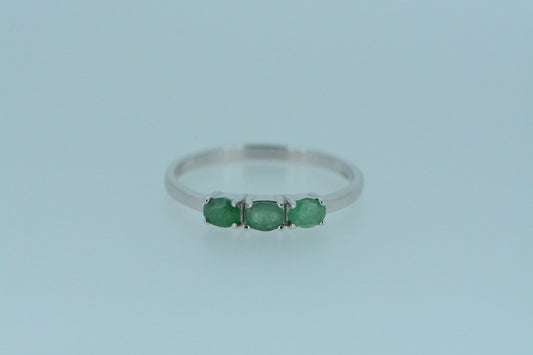Emerald Rings
Emeralds are a precious gemstone significantly rarer than diamonds and fine quality emeralds can be more valuable than diamonds too. They are known for their rich green hue and are historically associated with royalty, wealth, and wisdom.
---------
Emeralds are one of the most cherished and valuable gemstones in the world, renowned for their rich green colour and historical significance. Belonging to the beryl mineral family, emeralds owe their vibrant hue to trace amounts of chromium and, in some cases, vanadium. These minerals give emeralds their distinctive green colour, which can range from a light, grassy tone to a deep, forest green. The most prized emeralds display a vivid, evenly distributed colour with high saturation and minimal secondary hues like yellow or blue.
The history of emeralds dates back thousands of years. They were highly prized in ancient civilizations such as Egypt, where Cleopatra was famously fond of them. The Egyptians mined emeralds as early as 1500 BCE in a region that came to be known as Cleopatra’s Mines. Emeralds were also revered by the Incas and Aztecs in South America, particularly in what is now Colombia, which remains one of the leading sources of high-quality emeralds today.
Colombian emeralds are considered some of the finest in the world due to their clarity and intense colour. Other significant sources include Brazil, Zambia, and Afghanistan. Each location produces emeralds with slightly different characteristics. For instance, Zambian emeralds often have a bluish-green tint and are typically more transparent than those from other regions.
One of the defining features of emeralds is their natural inclusions, often referred to as the stone’s “jardin,” the French word for garden, due to their mossy appearance. These inclusions are common and accepted as part of the gem’s character. In fact, a flawless emerald is extremely rare and commands a very high price. Due to their fragility and tendency to fracture, most emeralds are treated with oils or resins to enhance their clarity and durability. These treatments are widely accepted in the gem trade but must be disclosed to buyers.
Emeralds are rated 7.5 to 8 on the Mohs scale of hardness, making them somewhat softer than other popular gemstones like diamonds and sapphires. This means they require careful handling and are often set in protective settings for jewellery, especially in rings and bracelets.
Beyond their physical beauty, emeralds have been surrounded by symbolism and lore. They have traditionally been associated with rebirth, love, and wisdom. In various cultures, emeralds were believed to offer protection, enhance intuition, and bring good fortune. The stone is also the birthstone for May and is often given as a gift for 20th or 35th wedding anniversaries.
Today, emeralds continue to captivate collectors, jewellers, and gem enthusiasts. Whether set in antique regal jewellery or modern custom designs, emeralds remain timeless symbols of elegance, luxury, and the enduring beauty of nature. Their striking colour, rich history, and rarity ensure their place as one of the most beloved and sought-after gemstones in the world.
What is an emerald?
An emerald is a green gemstone from the beryl mineral family, coloured primarily by chromium and sometimes vanadium. It is one of the four recognized precious gemstones, alongside diamond, ruby, and sapphire.
Where are emeralds found?
The most famous and high-quality emeralds come from Colombia, but they are also mined in Zambia, Brazil, Afghanistan, Ethiopia, and Zimbabwe.
What gives emeralds their green colour?
Emeralds owe their green colour to trace amounts of chromium and/or vanadium within the beryl crystal structure. The depth of green depends on the concentration of these elements.
Are emeralds rare?
Yes, especially high-quality emeralds with few inclusions. Flawless emeralds are extremely rare, which adds to their value.
What are inclusions in emeralds?
Inclusions are natural internal characteristics (like fractures or tiny minerals) that most emeralds have. They are often called "jardin" (French for "garden") because of their mossy or garden like appearance. Unlike diamonds, inclusions in emeralds are expected and can add character.
Are emeralds treated or enhanced?
Most emeralds are treated with oils or resins to improve their clarity. These treatments are standard in the industry and should always be disclosed when selling.
How hard are emeralds?
Emeralds rate 7.5 to 8 on the Mohs hardness scale, making them somewhat softer and more fragile than diamonds or sapphires. They should be worn with care to avoid chipping or cracking.
How do I care for emerald jewellery?
-
Avoid harsh chemicals and ultrasonic cleaners.
-
Clean gently with warm, soapy water and a soft brush.
-
Store separately to avoid scratches.
-
Periodically check for loosening in settings due to emeralds’ fragility.
What is the birthstone for May?
Emerald is the birthstone for May. It symbolizes rebirth, growth, love, and wisdom.
How valuable are emeralds?
Emerald value is determined by the 4 Cs: colour, clarity, cut, and carat weight. Colour is the most important factor — the richer and more vivid the green, the more valuable the stone.
Can emeralds be synthetic?
Yes, lab-grown (synthetic) emeralds exist and have the same chemical and physical properties as natural emeralds. They're typically more affordable and often have fewer inclusions.
-
Emerald Trilogy Ring
Regular price £59.99 GBPRegular priceUnit price / per

